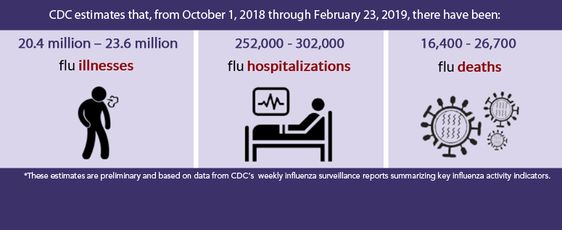
According to this week’s FluView report, seasonal influenza activity remains elevated and is similar to overall activity last week. Nationally, influenza-like illness (ILI) activity remains at 5.0 percent, and influenza activity is widespread in 49 states and Puerto Rico. Cumulatively, influenza A(H1N1)pdm09 viruses remain predominant for this flu season, however, the number of influenza A(H3) viruses continues to increase and, for the most recent week, accounts for slightly more than half of the subtyped influenza A viruses reported to CDC. Severity indicators remain substantially lower than what was observed last season. However, this week another 15 flu-related pediatric deaths were reported to CDC, bringing the total to 56 flu-related deaths in children reported to CDC for the 2018-2019 flu season.
CDC expects flu activity to remain elevated for a number of weeks. Below is a summary of the key flu indicators for the week ending Feb. 23, 2019:
- Influenza-like Illness Surveillance: For the week ending Feb. 23 (week 8), the proportion of people seeing their health care provider for influenza-like illness (ILI) remained at 5 percent, which is above the national baseline of 2.2 percent.
- All 10 regions reported a proportion of outpatient visits for ILI at or above their region-specific baseline levels.
- For comparison purposes, over the past five flu seasons, the peak percent of visits due to ILI has ranged between 3.6 percent (2015-2016) and 7.5 percent (2017-2018).
- Additional ILINet data, including national, regional, and select state-level data for the current and previous seasons, can be found at http://gis.cdc.gov/grasp/fluview/fluportaldashboard.html.
- Influenza-like Illness (ILI) State Activity Indicator Map: The number of states experiencing high ILI activity increased from 30 states plus New York City last week to 33 states plus New York City. The 33 states are Alabama, Alaska, Arizona, Arkansas, Colorado, Georgia, Illinois, Indiana, Kansas, Kentucky, Louisiana, Maryland, Massachusetts, Mississippi, Missouri, Montana, Nebraska, Nevada, New Jersey, New Mexico, New York, North Carolina, North Dakota, Oklahoma, Oregon, Pennsylvania, Rhode Island, South Carolina, Texas, Utah, Virginia, West Virginia, and Wyoming. The District of Columbia and eight states (California, Connecticut, Hawaii, Idaho, Iowa, Maine, South Dakota, and Vermont) experienced moderate ILI activity. Puerto Rico and eight states (Delaware, Florida, Michigan, Minnesota, Ohio, Tennessee, Washington, and Wisconsin) experienced low ILI activity. One state (New Hampshire) experienced minimal ILI activity. Data were insufficient to calculate an ILI activity level from the U.S. Virgin Islands. Additional data, including data for previous seasons, can be found at https://gis.cdc.gov/grasp/fluview/main.html. https://gis.cdc.gov/grasp/fluview/main.html.
- Geographic Spread of Influenza Viruses: The number of jurisdictions reporting widespread influenza activity increased from 48 states and Puerto Rico to Puerto Rico and 49 states (Alabama, Alaska, Arizona, Arkansas, California, Colorado, Connecticut, Delaware, Florida, Georgia, Idaho, Illinois, Indiana, Iowa, Kansas, Kentucky, Louisiana, Maine, Maryland, Massachusetts, Michigan, Minnesota, Mississippi, Missouri, Montana, Nebraska, Nevada, New Hampshire, New Jersey, New Mexico, New York, North Carolina, North Dakota, Ohio, Oklahoma, Oregon, Pennsylvania, Rhode Island, South Carolina, South Dakota, Tennessee, Texas, Utah, Vermont, Virginia, Washington, West Virginia, Wisconsin and Wyoming). Local influenza activity was reported by the District of Columbia and one state (Hawaii). Sporadic influenza activity was reported by the U.S. Virgin Islands. Guam did not report. Geographic spread data reflect how many areas within a state or territory are seeing flu activity. Additional data are available at: https://gis.cdc.gov/grasp/fluview/FluView8.html.
- Flu-Associated Hospitalizations: Since Oct. 1, 2018, 9,274 laboratory-confirmed influenza-associated hospitalizations have been reported through the Influenza Hospitalization Network (FluSurv-NET), a population-based surveillance network for laboratory-confirmed influenza-associated hospitalizations covering approximately 9% of the U.S. This translates to a cumulative overall rate of 32.1 hospitalizations per 100,000 people in the United States
- The highest hospitalization rate is among adults aged 65 years and older (91.5 per 100,000) followed by children younger than 5 years (45.5 per 100,000), and adults aged 50-64 years (43.2 per 100,000). During most seasons, adults 65 years and older have the highest hospitalization rates, followed by young children.li>
- For comparison purposes:
- The final, cumulative overall hospitalization rate for week 8 last season was 84. per 100,000.
- Over the past 5 seasons, cumulative end-of-season hospitalization rates have ranged from 31.4 per 100,000 (2015-2016) to 102.9 per 100,000 (2017-2018).
- Additional data, including hospitalization rates during previous influenza seasons, can be found at http://gis.cdc.gov/GRASP/Fluview/FluHospRates.html and http://gis.cdc.gov/grasp/fluview/FluHospChars.html.
- FluSurv-Net data is used to generate national estimates of the total numbers of flu cases, medical visits, and hospitalizations. This season, CDC is reporting preliminary cumulative in-season estimates, which are available at https://cdc.gov/flu/about/burden/preliminary-in-season-estimates.htm. Click to read more.
